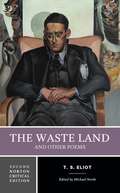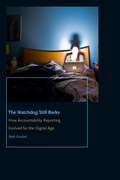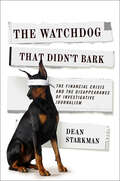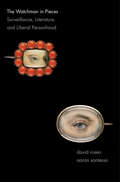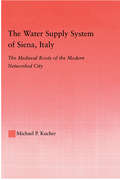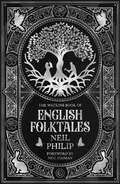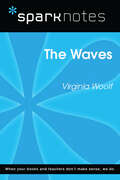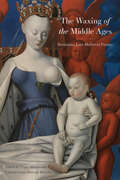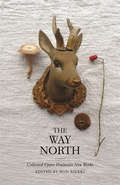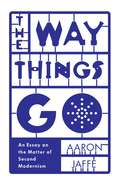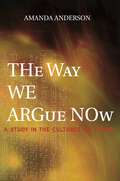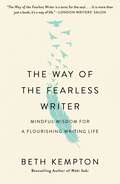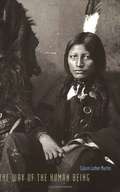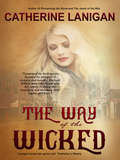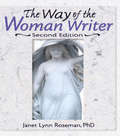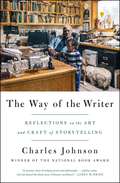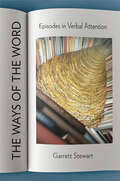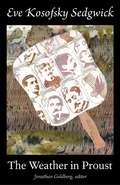- Table View
- List View
The Waste Land (Routledge Library Editions: T. S. Eliot Ser. #8)
by Grover SmithIn this study, first published in 1983, Professor Smith makes the argument that although The Waste Land is analogous in form to a musical composition that it is actually made of its literary echoes. He calls these a ‘music of allusions’ and shows the resemblance of this music in its evocativeness to the technique of Mallarmé and the French symbolists. Smith also comments extensively on Eliot’s critical theories as they bear on The Waste Land and traces the development of Eliot’s allusive and transformational poetic form from its genesis in early work. This title will be of interest to students of literature.
The Waste Land and Other Poems: A Norton Critical Edition (Norton Critical Editions #0)
by T. S. Eliot“This splendid new edition of T. S. Eliot’s The Waste Land will elucidate his legacy for a rising generation of students, teachers, and general readers. The inclusion of poems from Eliot’s first two collections, a substantial selection of background material and scholarship, expert annotation, and Michael North’s learned and incisive introduction detailing the development of Eliot’s poetic coming-of-age make this an invaluable resource.” —Anita Patterson, Boston University This Norton Critical Edition includes: The first American edition of The Waste Land, with Eliot’s notes, joined by Prufrock and Other Poems (1917) and Poems (1920). Updated and expanded introductory materials and footnotes by Michael North. Extensive contextual materials on sources for The Waste Land, its composition, and publication history for all three featured collections. Eleven reviews and reactions to Eliot’s works include those by Ezra Pound, Virginia Woolf, and Ralph Ellison. Five new critical essays examine the themes and legacy of Eliot’s hallmark poems alongside eight classic literary critiques. A chronology and a selected bibliography. About the Series Read by more than 12 million students over fifty-five years, Norton Critical Editions set the standard for apparatus that is right for undergraduate readers. The three-part format—annotated text, contexts, and criticism—helps students to better understand, analyze, and appreciate the literature, while opening a wide range of teaching possibilities for instructors. Whether in print or in digital format, Norton Critical Editions provide all the resources students need. “This splendid new edition of T. S. Eliot’s landmark poem provides an authoritative 1922 edition of the text, the most vital materials for understanding it, and, for this supremely allusive poem, a collection of essential sources. It also brings together Eliot’s most pertinent essays and all the English poems in his earlier books, as well as an illuminating array of reviews and criticism published over the last hundred years.” — Jahan Ramazani, University of Virginia
The Waste Land: A Biography Of A Poem
by Matthew HollisA riveting account of the making of T. S. Eliot’s celebrated poem The Waste Land on its centenary. Renowned as one of the world’s greatest poems, The Waste Land has been said to describe the moral decay of a world after war and the search for meaning in a meaningless era. It has been labeled the most truthful poem of its time; it has been branded a masterful fake. A century after its publication in 1922, T. S. Eliot’s enigmatic masterpiece remains one of the most influential works ever written, and yet one of the most mysterious. In a remarkable feat of biography, Matthew Hollis reconstructs the intellectual creation of the poem and brings the material reality of its charged times vividly to life. Presenting a mosaic of historical fragments, diaries, dynamic literary criticism, and illuminating new research, he reveals the cultural and personal trauma that forged The Waste Land through the lives of its protagonists—of Ezra Pound, who edited it; of Vivien Eliot, who sustained it; and of T. S. Eliot himself, whose private torment is woven into the seams of the work. The result is an unforgettable story of lives passing in opposing directions and the astounding literary legacy they would leave behind.
The Watchdog Still Barks: How Accountability Reporting Evolved for the Digital Age (Donald McGannon Communication Research Center's Everett C. Parker Book Series)
by Beth KnobelPerhaps no other function of a free press is as important as the watchdog role—its ability to monitor the work of the government. It is easier for politicians to get away with abusing power—wasting public funds and making poor decisions—if the press is not shining its light with what is termed “accountability reporting.” This need has become especially clear in recent months, as the American press has come under virulent direct attack for carrying out its watchdog duties. Upending the traditional media narrative that watchdog accountability journalism is in a long, dismaying decline, The Watchdog Still Barks presents a study of how this most important form of journalism came of age in the digital era at American newspapers.Although the American newspaper industry contracted significantly during the 1990s and 2000s, Fordham professor and former CBS News producer Beth Knobel illustrates through empirical data how the amount of deep watchdog reporting on the newspapers’ studied front pages generally increased over time despite shrinking circulations, low advertising revenue, and pressure to produce the kind of soft news that plays well on social media. Based on the first content analysis to focus specifically on accountability journalism nationally, The Watchdog Still Barks examines the front pages of nine newspapers located across the United States to paint a broad portrait of how public service journalism has changed since 1991 as the advent of the Internet transformed journalism. This portrait of the modern newspaper industry shows how papers of varying sizes and ownership structures around the country marshaled resources for accountability reporting despite significant financial and technological challenges.The Watchdog Still Barks includes original interviews with editors who explain why they are staking their papers’ futures on the one thing that American newspapers still do better than any other segment of the media: watchdog and investigative reporting.
The Watchdog That Didn't Bark: The Financial Crisis and the Disappearance of Investigative Journalism (Columbia Journalism Review)
by Dean StarkmanThe Pulitzer Prize-winning reporter details &“how the U.S. business press could miss the most important economic implosion of the past eighty years&” (Eric Alterman, media columnist for The Nation). In this sweeping, incisive post-mortem, Dean Starkman exposes the critical shortcomings that softened coverage in the business press during the mortgage era and the years leading up to the financial collapse of 2008. He examines the deep cultural and structural shifts—some unavoidable, some self-inflicted—that eroded journalism&’s appetite for its role as watchdog. The result was a deafening silence about systemic corruption in the financial industry. Tragically, this silence grew only more profound as the mortgage madness reached its terrible apogee from 2004 through 2006. Starkman frames his analysis in a broad argument about journalism itself, dividing the profession into two competing approaches—access reporting and accountability reporting—which rely on entirely different sources and produce radically different representations of reality. As Starkman explains, access journalism came to dominate business reporting in the 1990s, a process he calls &“CNBCization,&” and rather than examining risky, even corrupt, corporate behavior, mainstream reporters focused on profiling executives and informing investors. Starkman concludes with a critique of the digital-news ideology and corporate influence, which threaten to further undermine investigative reporting, and he shows how financial coverage, and journalism as a whole, can reclaim its bite. &“Can stand as a potentially enduring case study of what went wrong and why.&”—Alec Klein, national bestselling author of Aftermath &“With detailed statistics, Starkman provides keen analysis of how the media failed in its mission at a crucial time for the U.S. economy.&”—Booklist
The Watchman in Pieces
by Prof. David Rosen Prof. Aaron SantessoSpanning nearly 500 years of cultural and social history, this book examines the ways that literature and surveillance have developed together, as kindred modern practices. As ideas about personhood--what constitutes a self--have changed over time, so too have ideas about how to represent, shape, or invade the self. The authors show that, since the Renaissance, changes in observation strategies have driven innovations in literature; literature, in turn, has provided a laboratory and forum for the way we think about surveillance and privacy. Ultimately, they contend that the habits of mind cultivated by literature make rational and self-aware participation in contemporary surveillance environments possible. In a society increasingly dominated by interlocking surveillance systems, these habits of mind are consequently necessary for fully realized liberal citizenship.
The Water Supply System of Siena, Italy: The Medieval Roots of the Modern Networked City (Studies In Medieval History And Culture Ser. #29)
by Michael P. KucherThe book reviews scholarly literature and archival sources including maps and diagrams, to better situate Siena's achievement in urban history and broadens our understanding of medieval technology and urban life.
The Watkins Book of English Folktales
by Neil PhilipThis is a golden treasury of over one hundred English folktales captured in the form they were first collected in past centuries. Read these classic tales as they would have been told when storytelling was a living art – when the audience believed in boggarts and hobgoblins, local witches and will-o&’-the-wisps, ghosts and giants, cunning foxes and royal frogs. Find &“Jack the Giantkiller&”, &“Tom Tit Tot&” and other quintessentially English favourites, alongside interesting borrowings, such as an English version of the Grimms&’ &“Little Snow White&” – as well as bedtime frighteners, including &“Captain Murderer&”, as told to Charles Dickens by his childhood nurse.Neil Philip has provided a full introduction and source notes on each story that illustrate each tale&’s journey from mouth to page, and what has happened to them on the way. These tales rank among the finest English short stories of all time in their richness of metaphor and plot and their great verbal dash and daring.
The Waves (SparkNotes Literature Guide Series)
by SparkNotesThe Waves (SparkNotes Literature Guide) by Virginia Woolf Making the reading experience fun! Created by Harvard students for students everywhere, SparkNotes is a new breed of study guide: smarter, better, faster. Geared to what today's students need to know, SparkNotes provides: *Chapter-by-chapter analysis *Explanations of key themes, motifs, and symbols *A review quiz and essay topicsLively and accessible, these guides are perfect for late-night studying and writing papers
The Waxing of the Middle Ages: Revisiting Late Medieval France (The Early Modern Exchange)
by Zita Eva Rohr Tracy Adams Helen Swift Cynthia Brown Andrea Tarnowski Stephen Nichols Derek Whaley Anneliese Pollock Renck Charles-Louis Morand-Métivier Joan McRae Franck CollardJohan Huizinga’s much-loved and much-contested Autumn of the Middle Ages, first published in 1919, encouraged an image of the Late French Middle Ages as a flamboyant but empty period of decline and nostalgia. Many studies, particularly literary studies, have challenged Huizinga’s perceptions of individual works or genres. Still, the vision of the Late French and Burgundian Middle Ages as a sad transitional phase between the High Middle Ages and the Renaissance persists. Yet, a series of exceptionally significant cultural developments mark the period. The Waxing of the Middle Ages sets out to provide a rich, complex, and diverse study of these developments and to reassert that late medieval France is crucial in its own right. The collection argues for an approach that views the late medieval period not as an afterthought, or a blind spot, but as a period that is key in understanding the fluidity of time, traditions, culture, and history. Each essay explores some “cultural form,” to borrow Huizinga’s expression, to expose the false divide that has dominated modern scholarship.
The Way North: Collected Upper Peninsula New Works
by Ron RiekkiMichigan's Upper Peninsula is distinct from the rest of the state in geography, climate, and culture, including a unique and thriving creative writing community. In The Way North: Collected Upper Peninsula New Works, editor Ron Riekki presents poetry, fiction, and non-fiction from memorable, varied voices that are writing from and about Michigan's Upper Peninsula. In all, this unique anthology features new works from forty-two writers, including rising star Ellen Airgood, Edgar Award-winner Steve Hamilton, Rona Jaffe Award-winner Catie Rosemurgy, Jonathan Johnson of Best American Poetry, Michigan Notable Book Award-winner Keith Taylor, and Michigan Author Award-winner John Smolens. In 49 poems and 20 stories-diverse in form, length, and content-readers are introduced to the unmistakable terrain and characters of the U.P. The book not only showcases the snow, small towns, and idiosyncratic characters that readers might expect but also introduces unexpected regions and voices. From the powerful powwow in Baraga of April Lindala's "For the Healing of All Women" to the sex-charged basement in Stambaugh of Chad Faries's "Hotel Stambaugh: Michigan, 1977" to the splendor found between Newberry and Paradise in Joseph D. Haske's "Tahquamenon," readers will delight in discovering the work of both new and established authors. The contributors range widely in age, gender, and background, as The Way North highlights the work of established writers, teachers, students, laborers, fishermen, housewives, and many others. The Way North brings the U.P.'s literary tradition to the awareness of more readers and showcases some of the most compelling work connected to the area. It will be welcomed by readers interested in new fiction and poetry and instructors of courses on Michigan writing.
The Way Things Go: An Essay on the Matter of Second Modernism
by Aaron JaffeBuffed up to a metallic shine; loose fitting, lopsided, or kludgy; getting in the way or getting lost; collapsing in an explosion of dust caught on the warehouse CCTV. Modern things are going their own ways, and this book attempts to follow them. A course of thought about their comings and goings and cascading side effects, The Way Things Go offers a thesis demonstrated via a century-long countdown of stuff. Modernist critical theory and aesthetic method, it argues, are bound up with the inhuman fate of things as novelty becoming waste. Things are seldom at rest. Far more often they are going their own ways, entering and exiting our zones of attention, interest, and affection. Aaron Jaffe is concerned less with a humanist story of such things—offering anthropomorphizing narratives about recouping the items we use—as he is with the seemingly inscrutable, inhuman capacities of things for coarticulation and coherence. He examines the tension between this inscrutability on the one hand, and the ways things seem ready-made for understanding on the other hand, by means of exposition, thing-and-word-play, conceptual art, essayism, autopoesis, and prop comedy.Among other novelties and detritus, The Way Things Go delves into books, can openers, roller skates, fat, felt, soap, joy buzzers, hobbyhorses, felt erasers, sleds, magic rabbits, and urinals. But it stands apart from the recent flood of thing-talk, rebuking the romantic tendencies caught up in the pathetic nature of debris defining the conversation. Jaffe demonstrates that literary criticism is the one mode of analysis that can unpack the many things that, at first glance, seem so nonliterary.
The Way We Argue Now: A Study in the Cultures of Theory
by Amanda AndersonHow do the ways we argue represent a practical philosophy or a way of life? Are concepts of character and ethos pertinent to our understanding of academic debate? In this book, Amanda Anderson analyzes arguments in literary, cultural, and political theory, with special attention to the ways in which theorists understand ideals of critical distance, forms of subjective experience, and the determinants of belief and practice. Drawing on the resources of the liberal and rationalist tradition, Anderson interrogates the limits of identity politics and poststructuralism while holding to the importance of theory as a form of life. Considering high-profile trends as well as less noted patterns of argument, The Way We Argue Now addresses work in feminism, new historicism, queer theory, postcolonialism, cosmopolitanism, pragmatism, and proceduralism. The essays brought together here--lucid, precise, rigorously argued--combine pointed critique with an appreciative assessment of the productive internal contests and creative developments across these influential bodies of thought. Ultimately, The Way We Argue Now promotes a revitalized culture of argument through a richer understanding of the ways critical reason is practiced at the individual, collective, and institutional levels. Bringing to the fore the complexities of academic debate while shifting the terms by which we assess the continued influence of theory, it will appeal to readers interested in political theory, literary studies, cultural studies, gender studies, and the place of academic culture in society and politics.
The Way Women Are: Transformative Opinions and Dissents of Justice Ruth Bader Ginsburg
by Cathy CambronA collection of US Justice Ruth Bader Ginsburg&’s legal writings spanning her career, featuring her arguments, opinions, and dissents. US Supreme Court Justice Ruth Bader Ginsburg spent her life defying notions about women. She garnered the status of a cultural icon, the &“Notorious RBG.&” Her life story is inspirational, and her work ethic is aspirational. Ginsburg&’s dissents on behalf of liberal values have been lauded. She has been the subject of films and books, and her image has even been featured on everything from T-shirts to scented candles. But what is known about how her viewpoint shaped the development of law in the United States from the 1970s to 2020? The Way Women Are collects a broad range of Justice Ginsburg&’s legal writings, shedding light on who she was and what she contributed to American jurisprudence. The book begins with her arguments before the Supreme Court as a women&’s rights advocate in the 1970s. It proceeds to her opinions and dissents as a member of the Court. The opinions range from United States v. Virginia (1996) to Little Sisters of the Poor (2020)—a case she participated in from her hospital bed. Also included are a brief biography of Ginsburg and introductions to the writings that explain the background, issues, and laws involved in each case. Additionally, the collection includes oral arguments and bench announcements of decisions to make the issues more accessible. Altogether, The Way Women Are sketches an enlightening portrait of an extremely influential American jurist.
The Way of the Fearless Writer: Ancient Eastern wisdom for a flourishing writing life
by Beth KemptonA revolutionary approach to writing inspired by ancient Eastern wisdom, from the bestselling author of Wabi SabiJoin author and Japanologist Beth Kempton on a sacred journey to uncover the secrets of fearless writing which have lain buried in Eastern philosophy for two thousand years.In a radical departure from standard advice and widely-held assumptions about the effort and suffering required for creative success, The Way of the Fearless Writer will show you there is another way to thrive - a path of trust, ease, freedom and joy.Learn how to free your mind so your body can create, transform your relationship with fear, dissolve self-doubt, shift writer's block, access your true voice and bravely share your words with the world.This profound book reveals the deep connections between mind, body, spirit, breath and words. Offering a rare insight into the writing life and a host of fresh and original exercises, it will open your eyes to writing as a direct connection to life itself.Welcome to The Way of the Fearless Writer.
The Way of the Fearless Writer: Ancient Eastern wisdom for a flourishing writing life
by Beth KemptonA revolutionary approach to writing inspired by ancient Eastern wisdom, from the bestselling author of Wabi SabiJoin author and Japanologist Beth Kempton on a sacred journey to uncover the secrets of fearless writing which have lain buried in Eastern philosophy for two thousand years.In a radical departure from standard advice and widely-held assumptions about the effort and suffering required for creative success, The Way of the Fearless Writer will show you there is another way to thrive - a path of trust, ease, freedom and joy.Learn how to free your mind so your body can create, transform your relationship with fear, dissolve self-doubt, shift writer's block, access your true voice and bravely share your words with the world.This profound book reveals the deep connections between mind, body, spirit, breath and words. Offering a rare insight into the writing life and a host of fresh and original exercises, it will open your eyes to writing as a direct connection to life itself.Welcome to The Way of the Fearless Writer.
The Way of the Fearless Writer: Mindful Wisdom for a Flourishing Writing Life
by Beth KemptonA new, mindful approach to the writing lifeIn a radical departure from standard advice about creative success, effort, critique, and competition, The Way of the Fearless Writer will show you that there is another way to thrive—a writing path of ease, trust, wonder, and joy. You are invited to embark on a sacred writing journey. Along the way, author Beth Kempton will teach you how to free your mind so your body can create, transform your relationship to fear, write anytime, anywhere, and share your words with confidence. Being a fearless writer has little to do with validation and accolades. Rather it is about ritual, commitment, developing an acute awareness of beauty, dancing with inspiration, listening to the world outside yourself and going deep within. The Way of the Fearless Writer is your guide to this creative, transformational journey. This is not just a book about how to write better. It's a book about how to live better, with your heart as your compass and writing as your guide. Offering rare insight into the writing life and a host of fresh and original writing exercises, The Way of the Fearless Writer will reveal your true potential, and open your eyes to writing as a direct connection to life itself.
The Way of the Human Being
by Calvin MartinFrom Native Americans, Europeans learned about corn and beans, toboggans and canoes, and finding their way around an unfamiliar landscape. Yet the Europeans learned what they wished to learn―not necessarily what the natives actually meant by their stories and their lives―says Calvin Luther Martin in this unique and powerfully insightful book. By focusing on their own questions, Martin observes, those arriving in the New World have failed to grasp the deepest meaning of Native America. <p><p> Drawing on his own experiences with native people and on their stories, Martin brings us to a new conceptual landscape―the mythworld that seems unfamiliar and strange to those accustomed to western ways of thinking. He shows how native people understand the world and how human beings can and should conduct themselves within it. Taking up the profound philosophical challenge of the Native American “way of the human being,”
The Way of the Screenwriter
by Amnon BuchbinderA story is a living thing. And you don't work on a living thing, you work with it. This is the way of the screenwriter, and it is something that writer and director Amnon Buchbinder believes all masterful screenwriters understand intuitively: learning how to work with story through a painstaking process of trial, error, and self exploration. Amnon Buchbinder draws on his knowledge as a teacher and his experience as a script doctor and a story editor to explore this creative process. Along the way he illustrates principles often inspired by the philosophy of Laozi (Lao Tze) with examples drawn from major motion pictures such as Memento and The Piano. For the beginning or seasoned screenwriter who aspires to more than mere competence, Buchbinder illuminates a path towards mastery of the craft. For the lover of the cinematic experience, he opens a curtain to reveal a rarely seen world behind the big screen.
The Way of the Wicked
by Catherine LaniganTHE SINS OF THE FATHER They are heirs to a staggering fortune won through lies, greed and ruthless ambition—the children of Patrick Killian, who clawed his way up from poverty to build the gargantuan Emerald Chocolate empire in the lawless chaos of Prohibition Era Chicago. Caitlin, kind and loving, cursed by blind loyalty … and forbidden desire. Sheilagh, wild and beautiful, a creature of raw, blistering sensuality, seeking stardom and love beneath the bright lights of Broadway. And Michael, impelled by conscience to shun the keys to the kingdom … but shackled by suffocating, unbreakable bonds of family. Tormented by dark secrets, haunted by whispers of scandal and murder, they must now stand united against a gathering storm that could tear their house apart—and a devastating treachery that threatens their legacy … and their lives.
The Way of the Woman Writer
by Janet Lynn RosemanThe Way of the Woman Writer, Second Edition continues the work of the inspirational original, offering guidance to women who wish to document their lives in writing. More a template than a how-to manual, this insightful book addresses the concerns, needs, and issues of women writers (both aspiring and experienced), concentrating on the internal process of putting thought to paper, including new chapters on the creative process and the ethics and integrity of writing. The author, Dr. Janet Lynn Roseman, offers writing exercises in women's autobiography that draw on the significant rhythms of a woman's life, utilizing visualization and meditation techniques to amplify the inner writing voice. From the author: "What strikes me in re-examining the text of this book is just how timeless the subject of chronicling women's lives is. When we pass down our stories and share them with family and friends, we provide future generations with the opportunity to not only understand the lives of each woman, but we are able to gain insight into their unique experiences." The Way of the Woman Writer, Second Edition includes new writing samples and new chapters on: "The Creative Spirit," which presents a seven-step guide to the creative process-ritual, surrender, silence, waiting, trust, recognition, and distance "The Ethics and Integrity of Writing," which addresses the discipline and courage a writer needs when dealing with the effects of her autobiographical "truths" on others The Way of the Woman Writer, Second Edition is an essential resource for creative writing courses, oral history courses, writer's workshops, and women's studies programs, and an invaluable guide for any woman who wishes to tell her story.
The Way of the Writer: Reflections on the Art and Craft of Storytelling
by Charles JohnsonFrom Charles Johnson—a National Book Award winner, Professor Emeritus at University of Washington, and one of America&’s preeminent scholars on literature and race—comes an instructive, inspiring guide to the craft and art of writing.An award-winning novelist, philosopher, essayist, screenwriter, professor, and cartoonist, Charles Johnson has devoted his life to creative pursuit. His 1990 National Book Award-winning novel Middle Passage is a modern classic, revered as much for its daring plot as its philosophical underpinnings. For thirty-three years, Johnson taught and mentored students in the art and craft of creative writing. The Way of the Writer is his record of those years, and the coda to a kaleidoscopic, boundary-shattering career. Organized into six accessible, easy-to-navigate sections, The Way of the Writer is both a literary reflection on the creative impulse and a utilitarian guide to the writing process. Johnson shares his lessons and exercises from the classroom, starting with word choice, sentence structure, and narrative voice, and delving into the mechanics of scene, dialogue, plot and storytelling before exploring the larger questions at stake for the serious writer. What separates literature from industrial fiction? What lies at the heart of the creative impulse? How does one navigate the literary world? And how are philosophy and fiction concomitant? Luminous, inspiring, and imminently accessible, The Way of the Writer is a revelatory glimpse into the mind of the writer and an essential guide for anyone with a story to tell.
The Way to Write Science Fiction
by Brian StablefordThe writing of science fiction poses special problems, in addition to those involved in all fiction writing. Often the writer has to create a whole new world - invent a believable future or rewrite the past authentically. He has to design an alien world, and adapt human biology and geology to it. He must develop imaginary technology and avoid making elementary errors in science. He may even have to use language in an entirely new way. The Way To Write Science Fiction tackles all these subjects, as well as giving practical guidance on markets and the contemporary science fiction scene. Brian Stableford is supremely well-qualified to write this book; the author of over 30 science fiction novels, he is also the co-author of The Science in Science Fiction which won the 1985 European Science Fiction Award and has contributed to many reference books on literature in general and science fiction in particular.
The Ways of the Word: Episodes in Verbal Attention
by Garrett StewartIn The Ways of the Word, Garrett Stewart steps aside from theory to focus on the sheer pleasure of attentive reading and the excitement of recognizing the play of syllables and words upon which the best literary writing is founded. Emerging out of teaching creative writing and a broader effort to convene writers and critics, Stewart's "episodes in verbal attention" track the means to meaning through the byways of literary wording.Through close engagement with literary passages and poetic instances whose imaginative demands are their own reward, Stewart gathers exhibits from dozens of authors: from Dickinson, Dickens, and DeLillo to Whitman, Woolf, and Colson Whitehead. In the process, idiom, tense, etymology, and other elements of expressive language and its phonetic wordplay are estranged and heard anew. The Ways of the Word fluidly and intuitively reveals a verbal alchemy that is as riveting as it is elusive and mysterious.
The Weather in Proust
by Jonathan Goldberg Eve Kosofsky Sedgwick Michael MoonThe Weather in Proust gathers pieces written by the eminent critic and theorist Eve Kosofsky Sedgwick in the last decade of her life, as she worked toward a book on Proust. This book takes its title from the first essay, a startlingly original interpretation of Proust. By way of Neoplatonism, Buddhism, and the work of Melanie Klein, Sedgwick establishes the sense of refreshment and surprise that the author of the Recherche affords his readers. Proust also figures in pieces on the poetry of C. P. Cavafy, object relations, affect theory, and Sedgwick's textile art practices. More explicitly connected to her role as a pioneering queer theorist are an exuberant attack against reactionary refusals of the work of Guy Hocquenghem and talks in which she lays out her central ideas about sexuality and her concerns about the direction of US queer theory. Sedgwick lived for more than a dozen years with a diagnosis of terminal cancer; its implications informed her later writing and thinking, as well as her spiritual and artistic practices. In the book's final and most personal essay, she reflects on the realization of her impending death. Featuring thirty-seven color images of her art, The Weather in Proust offers a comprehensive view of Sedgwick's later work, underscoring its diversity and coherence.

